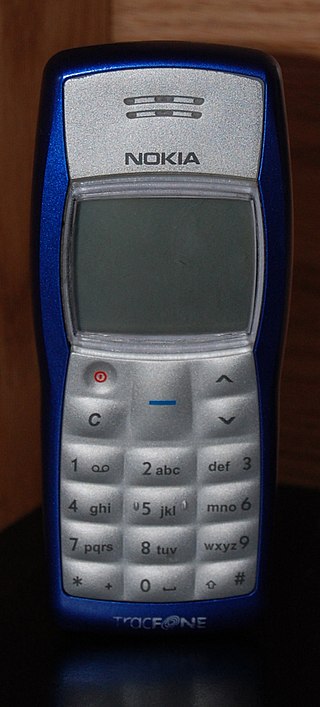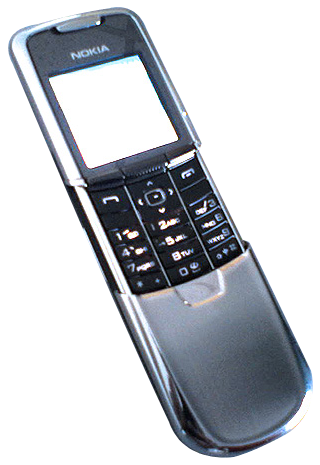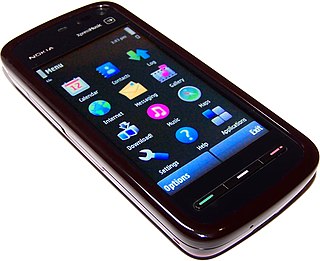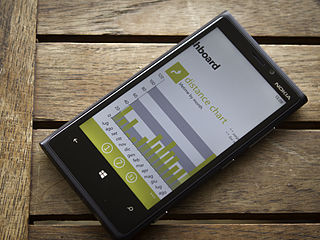
A smartphone is a mobile device that combines the functionality of a traditional mobile phone with advanced computing capabilities. It typically has a touchscreen interface, allowing users to access a wide range of applications and services, such as web browsing, email, and social media, as well as multimedia playback and streaming. Smartphones have built-in cameras, GPS navigation, and support for various communication methods, including voice calls, text messaging, and internet-based messaging apps.

The Nokia 6230 is a mobile phone based on the Nokia Series 40 platform. It was announced on 28 October 2003 and released in February 2004.
The Nokia 3310 is a discontinued GSM mobile phone announced on 1 September 2000, and released in the fourth quarter of the year, replacing the popular Nokia 3210. It sold very well, being one of the most successful phones, with 126 million units sold worldwide, and being one of Nokia's most iconic devices. The phone is still widely acclaimed and has gained a cult status due to its reputation for durability.

The Nokia 1100 is a basic GSM mobile phone produced by Nokia. Over 250 million 1100s have been sold since its launch in late 2003, making it the world's best selling phone handset and the best selling consumer electronics device in the world at the time. The model was announced on 27 August 2003 and was discontinued in September 2009.

The Nokia 3200 is a mobile phone by Nokia, part of the Nokia Expression (youth) series and announced on 12 September 2003. It is based on the Nokia Series 40 platform. The phone is an update of the Nokia 3100, while adding features from the Nokia 7250i and 6610i. The phone's feature set was very similar to the 7250i and 6610i, but featured different software and firmware installed, and was sold at a lower price than the 7250i or 6610i. Of the three phones, the 3200 was mainly targeted towards the youth market, the 7250i towards fashion-conscious users, and the 6610i towards business users. Core features include an XHTML browser, alarm clock, flashlight, EDGE and FM stereo radio with a 128 × 128 12-bit (4096) color screen. The phone has multimedia features such as picture and text messaging. Features carried over from the Nokia 3100 include ringer profiles and voice memo capability. It also has Java games. The phone has an extensive calendar with a lunar calendar. The flashlight is located under the phone and can be activated by holding the "star" (asterisk) key. The camera is on the back of the phone. The 3200 can also play both polyphonic and monophonic ringtones. The phone's visual interface in its menu system is similar to that of the Nokia 3100, using large, static icons rather than animated ones.

A mobile phone feature is a capability, service, or application that a mobile phone offers to its users. Mobile phones are often referred to as feature phones, and offer basic telephony. Handsets with more advanced computing ability through the use of native code try to differentiate their own products by implementing additional functions to make them more attractive to consumers. This has led to great innovation in mobile phone development over the past 20 years.

The Nokia 8800 is a luxury mobile phone produced by Nokia, based on the Nokia Series 40 operating system. The 8800 features a stainless-steel housing with a scratch-resistant screen and has a weight of 134 grams. According to Nokia, the 8800's "sophisticated slide mechanism uses premium ball bearings crafted by the makers of bearings used in high performance cars".

The Nokia 6310i is a mobile phone from Nokia first introduced at the CeBIT fair in March 2002 with sales starting later that year and discontinued in late 2005, it was Nokia's first tri-band phone offering. Primarily marketed as a business phone, it was for some years the dominant GSM device in the corporate world. The device was most commonly offered in Two-tone Silver/Grey or Two-tone Gold/Black trim; the third option, a Copper coloured variant, was much rarer.

The Motorola MicroTAC is a cellular phone first manufactured as an analog version in 1989. GSM-compatible and TDMA/Dual-Mode versions were introduced in 1994. The MicroTAC introduced a new "flip" design, where the "mouthpiece" folded over the keypad, although on later production the "mouthpiece" was actually located in the base of the phone, along with the ringer. This set the standard and became the model for modern flip phones today. Its predecessor was the much larger Motorola DynaTAC and it was succeeded by the Motorola StarTAC in 1996. "TAC" was an abbreviation of "Total Area Coverage" in all three models.
A mobile operating system is an operating system used for smartphones, tablets, smartwatches, smartglasses, or other non-laptop personal mobile computing devices. While computers such as typical/mobile laptops are "mobile", the operating systems used on them are generally not considered mobile, as they were originally designed for desktop computers that historically did not have or need specific mobile features. This line distinguishing mobile and other forms has become blurred in recent years, due to the fact that newer devices have become smaller and more mobile unlike hardware of the past. Key notabilities blurring this line are the introduction of tablet computers, light-weight laptops, and the hybridization of the two in 2-in-1 PCs.
Samsung Mobile Division is one of the five divisions within Samsung Electronics, belonging to the Samsung Group, and consists of the Mobile Communications Division, Telecommunication Systems Division, Computer Division, MP3 Business Team, Mobile Solution Centre, and Telecommunication R&D Centre. Telecommunication Business produces a full spectrum of products from mobiles and other mobile devices such as MP3 players and laptop computers to telecommunication network infrastructure. The headquarters is located in Suwon, South Korea.

Nokia 5800 XpressMusic is a smartphone part of the XpressMusic line, announced by Nokia on 2 October 2008 in London and started shipping in November of that year. Code-named "Tube", it was the first touchscreen-equipped S60 device by Nokia – essentially it was the first device to run Symbian^1, also known as S60 5th Edition, the touch-specific S60-based platform created by the Symbian Foundation. The touchscreen features tactile feedback.

The Nokia N900 is a smartphone made by Nokia. It supersedes the Nokia N810. Its default operating system, Maemo 5, is a Linux-based OS originally developed for the Nokia 770 Internet Tablet. It is the first Nokia device based upon the Texas Instruments OMAP3 microprocessor with the ARM Cortex-A8 core. Unlike the three Nokia Internet tablets preceding it, the Nokia N900 is the first Maemo device to include phone functionality.
Nokia's strategic nomenclature can be traced back in 2005 when the Nseries line was launched, offering devices with flagship specifications and premium hardware at various price points. These devices were considered the "bread and butter" of the company and were often positioned to showcase their latest technologies. Thanks to the newfound consumer and enterprise interest in smartphones at the time, the company introduced four additional collections to diversify their product portfolio and meet demands in most market segments. These new phone series were named Eseries, targeting small business and enterprise customers; Xseries, providing consumer-grade multimedia-focused devices; Cseries, which Nokia used to target both the low-end and mid-range market segments; and Tseries, for devices exclusive to the Chinese market.
The Nokia 8810 is a discontinued slider-style mobile phone announced and manufactured by Nokia in 1998. It is notable for being among the first mainstream mobile devices to have an internal antenna, although the very first is regarded as the TCP-6000, released as the Hagenuk GlobalHandy.

Nokia Lumia 920 is a smartphone developed by Nokia that runs the Windows Phone 8 operating system. It was announced on September 5, 2012, and was first released on November 2, 2012. It has a 1.5 GHz dual-core Qualcomm Krait CPU and a 4.5" IPS TFT LCD display, as well as a high-sensitivity capacitive touchscreen that can be used with gloves and fingernails; the display is covered by curved Gorilla Glass and has a 9 ms response time. The phone features an 8.7-megapixel PureView camera with OIS; it was the first smartphone camera to implement that technology, as well as to support Qi inductive charging. The phone comes with 32 GB of internal storage, but has no expandable storage.

The Nokia Lumia 820 is a smartphone designed, developed and marketed by Nokia. It is the successor to the Lumia 800 and is one of the first Nokia phones to implement Windows Phone 8 alongside the Nokia Lumia 920. Although sharing a similar appearance with the Lumia 800, the Lumia 820 is a major overhaul over its predecessor, sporting a 4.3 inches (110 mm) diagonal OLED display with scratch resistant glass, though lacking Gorilla Glass protection, 1.5 GHz dual-core processor, and an 8.7-megapixel camera. The phone will come with LTE connectivity and a wireless-charging option. The 820 is the first Nokia Windows Phone OS based smartphone to embed a microSD card slot.

The Nokia X family was a range of budget smartphones that was produced and marketed by Microsoft Mobile, originally introduced in February 2014 by Nokia. The smartphones run on the Nokia X platform, a Linux-based operating system which was a fork of Android. Nokia X is also known generally as the Nokia Normandy. It is regarded as Nokia's first Android device during the company's Microsoft partnership and was in the process of selling its mobile phone business to Microsoft, which eventually happened two months later.

Human Mobile Devices (HMD), formally HMD Global, is a Finnish mobile phone manufacturer. The company is made up of the mobile phone business that the Nokia Corporation sold to Microsoft in 2014, then bought back in 2016. HMD began marketing Nokia-branded smartphones and feature phones on 1 December 2016. The company has exclusive rights to the Nokia brand for mobile phones through a licensing agreement. The HMD brand was initially only used for corporate purposes and does not appear in advertising, whereas the name "Nokia Mobile" is used on social media. As it was launched, the acronym HMD stood for Hon Hai Mobile Devices. This was in reference to the main shareholder at the time of its creation: the Taiwanese group Foxconn. In January 2024, HMD rebranded to 'Human Mobile Devices', and will use their own branding on future devices alongside that of Nokia.

The Nokia 3310 (2017) is a Nokia-branded feature phone developed by HMD Global. It was announced on 26 February 2017 at Mobile World Congress (MWC) 2017 as a revival of the original Nokia 3310 that was produced from the early 2000s. An improved model with 3G support was released on 29 October 2017.















